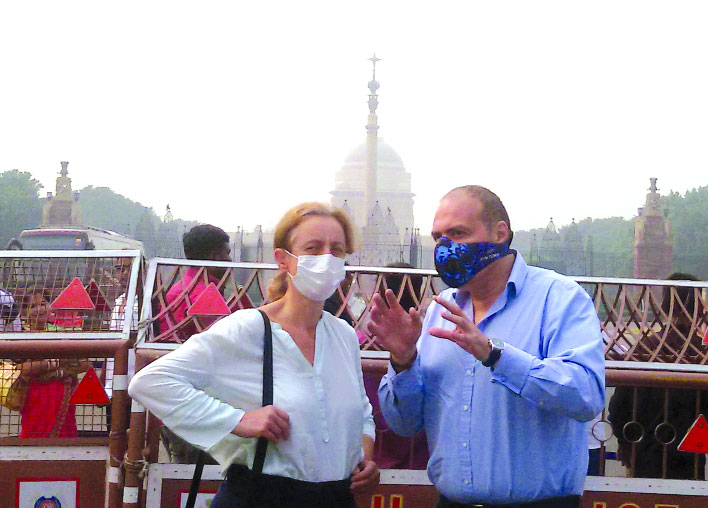The chairman of the Supreme court-appointed Environment Pollution (Prevention and Control) Authority (EPCA), Bhure Lal, has tossed up an alarming suggestion to deal with the apprehension that air pollution in the national Capital could further worsen. Ban plying of all private vehicles!
Bhure Lal’s remark has sent shock waves. If his suggestion is implemented at any stage, it could lead to a complete shutdown of Delhi as people are largely dependent on their own vehicles for commuting. Delhi has more vehicles as compared to Mumbai, Kolkata, Chennai and Bangaluru combined.
Emerging from the Supreme Court, Bhure Lal on Tuesday said that the Graded Action Response Plan (GRAP) will be implemented from November 1, and if air pollution continued to worsen, private vehicles will be stopped in Delhi.
The GRAP is an emergency plan designed to take urgent remedial action when air quality deteriorates.
“Let us hope Delhi air pollution situation doesn’t deteriorate or else will have to stop plying of private vehicles, only public transport will be used,” Bhure Lal added. Detailed provisions of the rule, if applied, have not been made known yet.
Reacting to Bhure Lal’s statement, majority of people said that there will be a complete shutdown in Delhi if the Government stops using private vehicles. “The exchequer will incur loss of hundreds of crores in even one day of shutdown,” they said.
Interestingly, public transport system of the Capital is crippled due to ongoing strike by DTC bus drivers and conductors and shortage of buses. The city needs 11,000 buses - it has only 5,429 buses. Of the 464 routes in Delhi, buses don’t run on five while on 75 routes, only one bus operates. Nearly half (230) routes have one to five buses operating. The situation is as dire in the cluster services, managed by the Delhi Integrated Multi-Modal Transit System (DIMTS) as 40 of its 147 routes are served by just one to five buses each. Together, they take more trips than the Delhi Metro.
Approximately seven lakh vehicles are being registered in a year in Delhi and the law does not prescribe any limit for purchase of motor vehicles in the name of any person. Total number of registered vehicles in Delhi has crossed over 1.45 crore. Between April 1, 2017, and March 31, 2018, as many as 7,20,519 vehicles were registered in Delhi. Of these, 4,76,691 are two-wheelers. As per data, total 6,61,494 vehicles were registered in 2015 and 6,93,159 vehicles in 2016.
The Supreme Court-appointed EPCA had informed the apex court on Monday that commercial vehicles like trucks and taxis were the major source of pollution in the national Capital and that there was a need to control their operation. “Out of all the vehicles, heavy commercial ones like trucks and other commercial vehicles such as taxis are the major polluting source, with very high carbon monoxide and nitrogen oxide emissions,” it said.
“There is a western disturbance approaching Delhi and the combination of increased moisture makes it likely that the air quality will dip significantly. This means that there is an urgent need to take action against existing factors leading to air pollution,” said officials adding the pollutants at lower levels are not able to disperse due to the light winds and smog can be easily seen.
“Due to western disturbances, the wind speed is 2.5 km per hour,” officials added.
Crop stubble burning, a major source of pollution, vehicular exhaust and a drop-off in wind speeds have aggravated the smog that is likely to worsen around 7 November, when fireworks will set off to celebrate the major Hindu festival of Diwali. EPCA has already proposed halting construction, the use of diesel-run power generators, brick kilns and the burning of garbage between November 1 and November 10 when pollution levels are expected to rise.
According to the World Health Organisation (WHO) report titled, “Air pollution and child health: Prescribing clean air”, India topped the list of air pollution-induced deaths in children below the age of five, with over 1.25 lakh children dying in 2016 in the country due to polluted air.
A 2016 study by IIT-Kanpur had found that vehicular emissions contribute to around 9 per cent of the PM10 load in Delhi and around 20 per cent of the PM2.5 load. A study by TERI and Automobile Research Association of India (ARAI) in its study had also found that the contribution of vehicular emissions in Delhi’s air could go up to 30 per cent if secondary particles are taken into account.
The Ministry of Environment and Forests had in 2003 published a white paper that reported that in the three decades between 1970-71 and 2000-01, the contribution of vehicles to particulate matter in Delhi’s air had more than trebled to 72 per cent from 23 per cent.


























